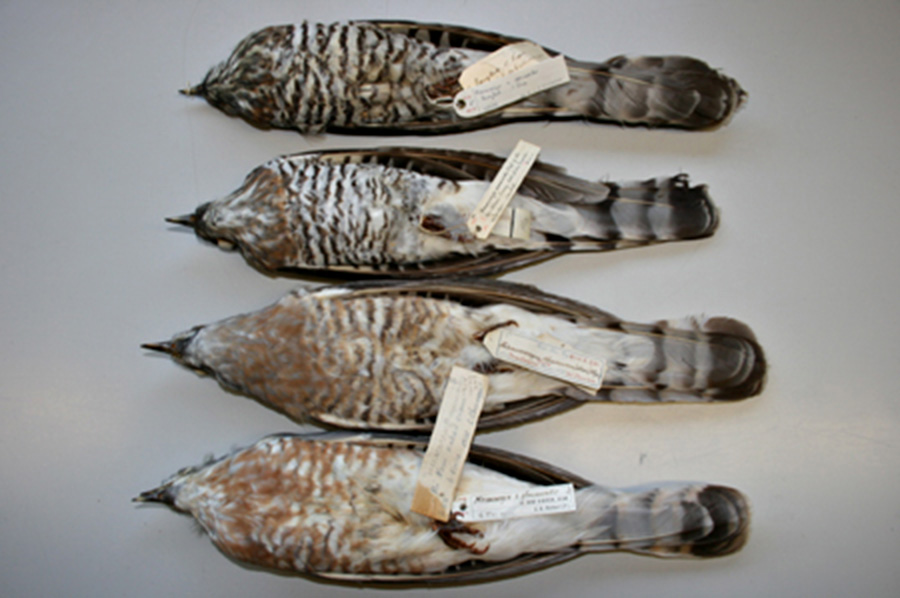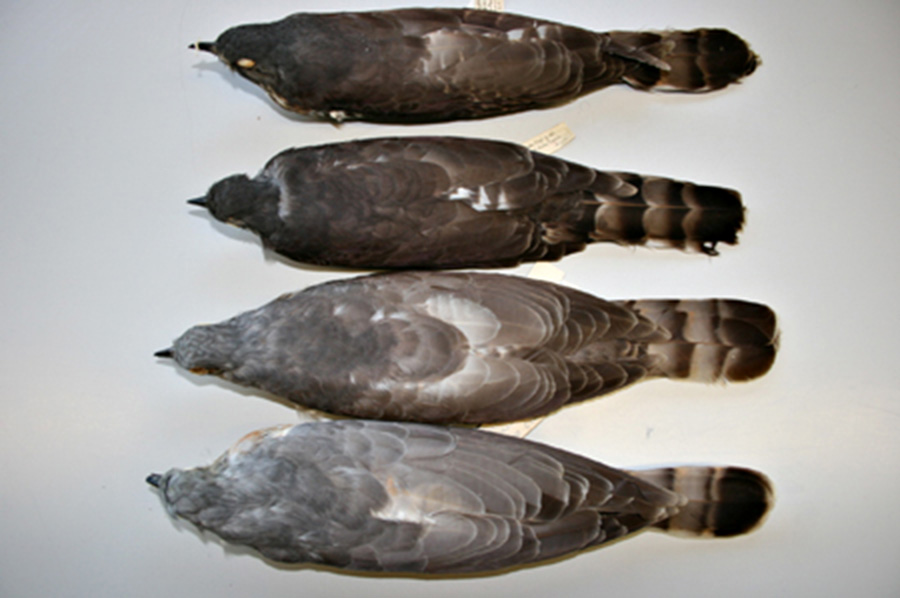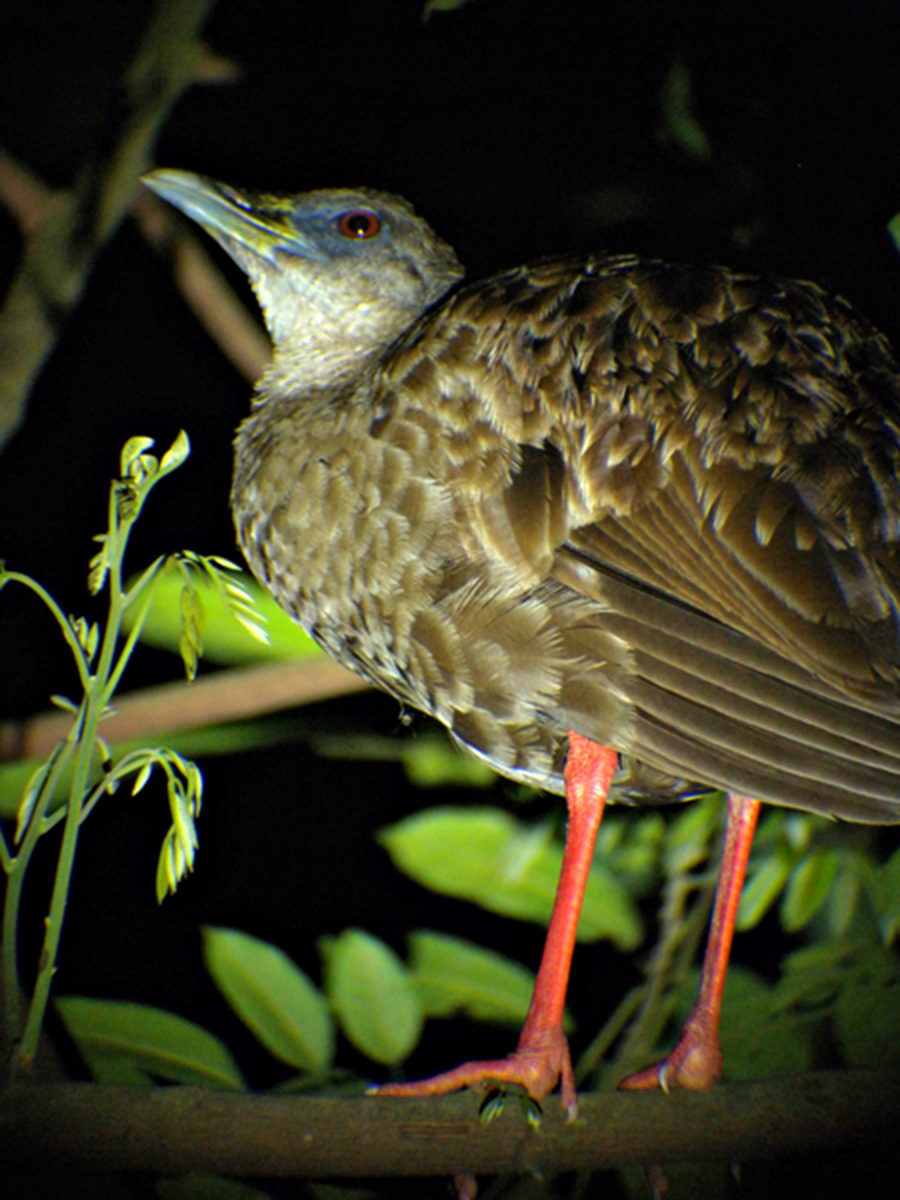29 October 2011 — Birds of South and Middle America — recent advances in knowledge. A joint BOC, Neotropical Bird Club, Natural History Museum meeting held at the Natural History Museum, London.
This was the first of a planned series of joint meetings to be held by the BOC and NHM in conjunction with various regional bird clubs. The day’s programme was scheduled as six 45-minute talks, three before lunch and three after. The morning got underway with an illuminating talk from Natalie Seddon entitled Understanding biodiversity: insights from Amazonian birds. This was a last-minute change from the published title but it proved to be a fascinating insight into recent advances in our knowledge of taxonomic relationships and the incredible diversity of birds in Amazonia. She was followed by Huw Lloyd who spoke eloquently about conservation of high-Andean forest birds in Peru and the problems resulting from the fragmentation and degradation of high-altitude Polylepis woodlands. After two serious and thought-provoking presentations, James Lowen treated us to a glorious celebration of the wildlife of the Pantanal. This was no ordinary travelogue, however, and his beautifully illustrated and informative talk left me with an immediate desire to go there. After lunch Cristina Banks-Leite demonstrated how the understorey bird community of the Atlantic Forest of Brazil responds to habitat loss, fragmentation and degradation, based on a programme involving the capture of 7,000 birds of 140 species. The final talks took us to the most diverse country in the Neotropics. Robert Prys-Jones described the tri-national Project BioMap initiative whose aim has been to digitise and georeference all specimens of Colombian birds around the world. Cataloguing >200,000 skins has provided a valuable conservation resource, highlighting the strengths and weaknesses in our knowledge of bird distribution in Colombia. Finally, Thomas Donegan explored recent advances in knowledge of Colombian birds, describing some of the new discoveries and discussing changes to Colombia’s ever-increasing bird list as a result of taxonomic research. He also highlighted some of the steps being taken to conserve the country’s birds and habitats.
The organisers should be congratulated for putting together such an interesting and diverse selection of talks. The tone was academic but accessible, ensuring a broad appeal. The one talk that was more pictorial than academic was brilliantly conceived and delivered, and all of the speakers were well chosen. The chairing of the meeting could have been a little tighter, but overall this was a thoroughly enjoyable symposium and I look forward to others covering different regions of the world.
Nigel Redman
11 October 2011 — Back from the brink: translocation of threatened endemic birds in the Seychelles — Rachel Bristol
Rachel Bristol spoke on the subject of the translocation of threatened endemic birds in the Seychelles. The main threats to Seychelles endemic birds are habitat loss and introduced predators, particularly cats and rats, which have occurred since human colonisation of the Seychelles began in the 1770s. The majority of the original forest cover was rapidly removed for plantation agriculture, predominantly coconuts in coastal plateau areas and cinnamon in the mountains, and rats and cats quickly spread to most islands. As a result, several species became extinct, including Seychelles Parakeet Psittacula wardi and Seychelles Chestnut-flanked White-eye Zosterops semiflavus, while others came perilously close. Seychelles Magpie-Robin Copsychus sechellarum was originally resident on most, if not all, the granitic islands, but was lost from all except Frégate (219 ha), where a tiny population of 11–30 individuals clung on for c.40 years until a recovery programme was instigated in 1990. Seychelles Warbler Acrocephalus sechellensis was reduced to a tiny population of 28–30 individuals on Cousin (26 ha) and Seychelles Paradise Flycatcher Terpsiphone corvina became extinct on all islands except La Digue.
To increase the numbers, range and survival prospects of five of the eight Seychelles threatened endemic birds, translocations (reintroductions and conservation introductions) have been used in tandem with habitat rehabilitation to create additional island populations of these birds. Due largely to translocations, we now have over 200 Seychelles Magpie-Robins on five islands, >3,000 Seychelles Warblers on four islands, Seychelles White-eyes Zosterops modestuson five islands, Seychelles Fodies Foudia sechellarum on five islands and Seychelles Paradise Flycatchers now have a second population on Denis. After some initial translocation failures in the 1970s and 80s, translocation methods have been continually refined and Seychelles now achieves consistent translocation success. Keys to success have been: ensuring all the species’ habitat requirements are provided in the new environment (for example, habitat rehabilitation prior to release, predator management, provision of nest boxes and supplementary food), translocating only wild birds and tailoring the release methods to the species. In addition, intensive post-release monitoring is always undertaken to monitor survival and breeding of the released individuals, and also to detect any problems so that mitigation actions can be undertaken if necessary.
14 June 2011 — Short talks by members of the club
A series of short talks was presented, starting with Nigel Redman, who first discussed What is Sharpe’s Lark? In 1896 D. G. Elliot collected a lark in British Somaliland that he described as Mirafra sharpii. It was later subsumed within Rufous-naped Lark M. africana, a widespread species whose races range from pale to dark, although none is as rufous as sharpii. In 1918–20 Sir Geoffrey Archer collected a further 14 specimens in Somaliland, mostly on the Tuuyo Plain where it apparently overlapped with the very similar Somali Lark M. somalica. Whilst Somali Lark’s range extends east from here, Sharpe’s extends west to the Ethiopian border, with just one record in Ethiopia. There have only been a handful of sightings of Sharpe’s Lark since, and the taxon is recorded from only six squares inBirds of Somalia. It inhabits open grassy plains in areas of open dry woodland, but the nest has never been found and no photographs or sound-recordings exist. Sharpe’s Lark is surprisingly similar to Somali Lark, both being very rufous in overall coloration (Somali Lark is slightly paler). The key consistent differences are bill length (short in Sharpe’s, usually much longer in Somali), outer tail colour (buff in Sharpe’s, white in Somali) and hindclaw length and shape (shorter than hind toe and strongly arched in Sharpe’s, and longer than hind toe and almost straight in Somali). Furthermore, Somali shows more spotting on the undertail-coverts. Their similarity raises the question of whether Sharpe’s Lark might be a race of Somali Lark rather than Rufous-naped Lark, but the differences, though subtle, do seem too marked, especially the hindclaw. It therefore seems best to treat sharpii as a species for now. It is disconcerting that the first bird tours to Somaliland in 2010 found Somali but not Sharpe’s Lark on the Tuuyo Plain. We can only hope that this interesting taxon has managed to cling on somewhere in north-west Somalia (or in eastern Ethiopia) and that a population will be relocated soon.
Nigel went on to consider Species, races or morphs: taxonomic confusion in the Tropical Boubou complex, in a talk that further considered issues raised by Turneret al. (Bull. Brit. Orn. Cl. 131: 125–128) in relation to a recent molecular study (Nguembock et al., Mol. Phyl. & Evol. 48: 396–407). Turner et al. reported that the black ‘morph’ of Laniarius (aethiopicus) sublacteus in coastal Kenya lives side by side with black-and-white sublacteus, and they apparently behave as separate species. The situation in southern Somalia is not well known, but the black morph of L. (a.) erlangeri reportedly calls very differently from normal Tropical Boubous. Turner et al. overlooked that Nguembock et al.’s study did in fact sample the black ‘morph’ of erlangeri and therefore it is this bird that is more distantly related to other black-and-white boubous. Nigel suggested that the all-black Somali and Kenyan birds must be synonymous, but L. erlangeri is inappropriate as the Kenyan birds were named L. nigerrimus in 1879, 26 years before erlangeri was described. This ‘new’ species requires an English moniker and Reichenow’s name Black Boubou seems sensible. But the question remains, what are the black-and-white birds in the Jubba Valley in southern Somalia? It would be logical for them to besublacteus, like those in Kenya, but the Somali birds often show a short wingbar, which sublacteus lacks. However, three of 30 adult sublacteus in Tring had one or two white feathers on the shoulder, so there is clearly some variation. Until a fuller genetic analysis is made, including all relevant taxa, we can only speculate.
Clive Mann spoke on Two tropical cuckoo problems, starting with plumage coloration in Large Hawk-Cuckoo Hierococcyx sparverioides. This species ranges from the Himalayas to southern China and South-East Asia, with small numbers from northern populations migrating south to the Philippines and Greater Sundas. It breeds at 900–3,500 m, but migrants are found to sea level. Five unusually plumaged specimens (four male, one unsexed) in the collection at Tring were collected between 1863 and 1915 in Burma (four) and Thailand (one), from three localities near sea level, one at 1,500 m and one untraced. Four were taken in October–January, but that from the untraced locality in August. They differ in being silvery grey above (usually blackish brown), with a chestnut throat and the barring below much paler and more rufous. Although one collector remarked on the silvery colour in his notes, nothing appears to have been published on this plumage. Clive initially thought they represented an undescribed taxon, but there appear to be no structural or biometric differences, and the plumage differences could have resulted from a simple genetic mechanism, perhaps just one mutation, causing the dilution of melanin pigments. Such a variant, referred to as ‘pastel’, is known in other birds, whereby the black eumelanin becomes grey and the reddish-brown phaeomelanin becomes yellowish brown. On this basis he considered it more logical to view them as a morph of sparverioides. The dates suggest that they could be wintering birds, although August is perhaps anomalous, but if they are where did they come from?

Large Hawk-cuckoo Hierococcyx sparverioides (1) ventral view: top two normal morph, bottom two undescribed pale morph (©Clive Mann)

Large Hawk-cuckoo Hierococcyx sparverioides (2) dorsal view: top two normal morph, bottom two undescribed pale morph (©Clive Mann)
Clive then discussed the northern subspecies of Oriental Cuckoo Cuculus(saturatus) optatus, which breeds from European Russia east to Japan. It migrates to southern Asia and Australasia, with vagrants recorded in the Pacific and North America, and twice in Israel. A specimen of a hepatic morph female Cuculuscollected by Boyd Alexander in December 1898 in Zambia is in the Tring collection, with the African Cuckoos C. gularis. It was originally labeled C. canorus, but in Clive’s opinion is obviously different to both gularis and canorus, notably in the rump / uppertail-coverts. The former species has much grey amongst the rufous and dark brown barring, whereas the latter generally has an almost unmarked rufous rump, although juveniles may have dark brown barring as in the Boyd Alexander specimen, but have narrow whitish fringes to the feathers (lacking in the specimen in question). He found it difficult to distinguish the specimen from alloptatus examined (saturatus is extremely similar to optatus, but smaller) and provisionally considers that the specimen represents the sole record of Oriental Cuckoo in Africa.
David Fisher presented The first-ever photographs of Nkulengu Rail? Whereas in former years members commonly exhibited ‘novelties’, i.e. specimens of potentially new taxa, David showed what he believed to be the first-ever ‘consciously taken’ photographs of Nkulengu Rail Himantornis haematopus, of a bird in Ghana on 9 May 2011 (two poor photographs taken by automated camera traps can be seen on the internet). This species, whose range stretches from West Africa to Uganda, is of interest for several reasons. It is loudly vocal pre-dawn and post-dusk, and in one recent field guide its call is described as sounding like a ‘dancing conga-line going through the forest’! The species is notoriously hard to see but, as the camera trap photos prove, it is active by day as well as at night. This rail is considered to be the sole member of its own subfamily, based primarily on its skeleton, which differs dramatically from other rails, being much closer to the South American trumpeters (Psophiidae). Unlike other rails, juveniles possess highly patterned down. Compared to illustrations in books, David’s photographs differed primarily in the bare-part colours. The legs are usually painted (correctly) as bright red, but the bill as either uniform grey or uniform black, whereas in life it is silvery blue with a lime-green base. The lores are also usually painted grey or black, whereas they are greyish blue in life. Presumably these discrepancies are due to illustrations being based on skins in which the colours have faded. The photographs will shortly be made public via several websites and elsewhere.

Nkulengu Rail Himantornis haematopus. (©David Fisher)
Douglas Russell’s talk was entitled Con artist or unfairly maligned collector?—the rediscovery of William Farren’s Black Woodpecker eggs from the New Forest. The status of Black Woodpecker Dryocopus m. martius in Britain and Ireland has long been controversial. The last review, by the BOU Records Committee (Ibis 137: 590–591) considered 110 alleged records, but unanimously concluded there was no unequivocal evidence of the species occurring in the last 200 years. Prior to this, R. S. R. Fitter (Bull. Brit. Orn. Cl. 79: 79–87, 102–113; revisited in Birding World5: 75–77) compiled a comprehensive list of Black Woodpecker records, categorising at least 26 as now or formerly supported by specimens and ‘in one case a clutch of eggs’. For over a century this clutch was presumed lost to science. However, examination of the Milton Abbey School Collection, acquired by the Natural History Museum, Tring, in 2001, revealed several overlooked manuscripts that suggested its presence in the collection, which appears to have been formerly in the possession of the Beavan-Rake family. In 1862, William Farren (1836–87), a well-known naturalist and dealer, detailed in The Zoologist collecting the clutch on 9 June 1862 at Pignel, near Brockenhurst, Hampshire, in the New Forest. He subsequently passed the eggs to his friend John de Capel Wise (1831–90) for authentication. The manuscripts indicated that Wise, who mentioned the eggs in his book The New Forest: its history and scenery (1883), had subsequently sold them to the surgeon and collector Thomas Beavan-Rake. Three of the original clutch of four have now been found. Measurements and comparison with other European Black Woodpecker and Green Woodpecker Picus viridis eggs are inconclusive, but their identification can potentially be determined by molecular investigation. However, an answer to the central question of whether the clutch was actually taken in the New Forest will remain disappointingly elusive in the absence of an unambiguous method for determining a clutch’s laying locality.
Lengthy discussion of the above meant insufficient time was available for Robert Prys-Jones’s projected talk on Type specimens of the Imperial Woodpecker: confusion resolved?
29 March 2011 – Singing in the rainforest: ornithological adventures in Amazonia – Joe Tobias
Joe Tobias spoke about the Neotropical ornithology research programme he is currently developing at the Edward Grey Institute in the Zoology Department at Oxford University. He commenced with a quick ‘tour’ to depict a representative sample of Amazonian bird diversity, including endemic families such as trumpeters (Psophiidae) and Hoatzin Opisthocomus hoazin (Opisthocomidae), and other key components of Neotropical avian communities such as guans (Cracidae), motmots (Momotidae), toucans (Ramphastidae) and jacamars (Galbulidae). He then reviewed current efforts to understand the ecology and behaviour of Amazonian birds, and to explain Amazonian diversity, which ranks as the highest in the world in terms of the number of species co-existing at single localities. Turning to research on antbirds (Thamnophilidae) he discussed recent findings from field observations and experiments that males and females sing year-round, often in duets, and that the function of male and female songs varies with context, sometimes reflecting cooperation and at other times conflict between the sexes. He also described how strong competition between antbird species has driven convergence in songs in some closely related species-pairs. At a regional scale, recent studies of Amazonian bird ranges provide support for Alfred Russel Wallace’s hypothesis that riverine barriers help to explain the divergence of avian lineages in the Amazon basin, and ultimately shape the patterns of diversity found today.
















